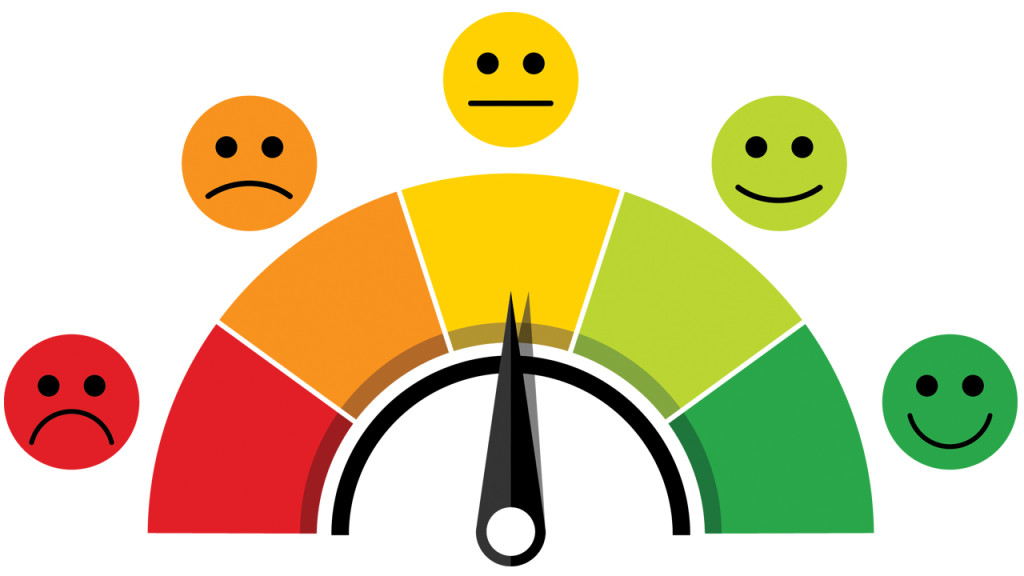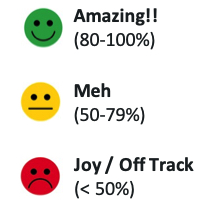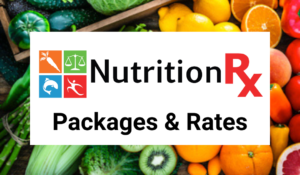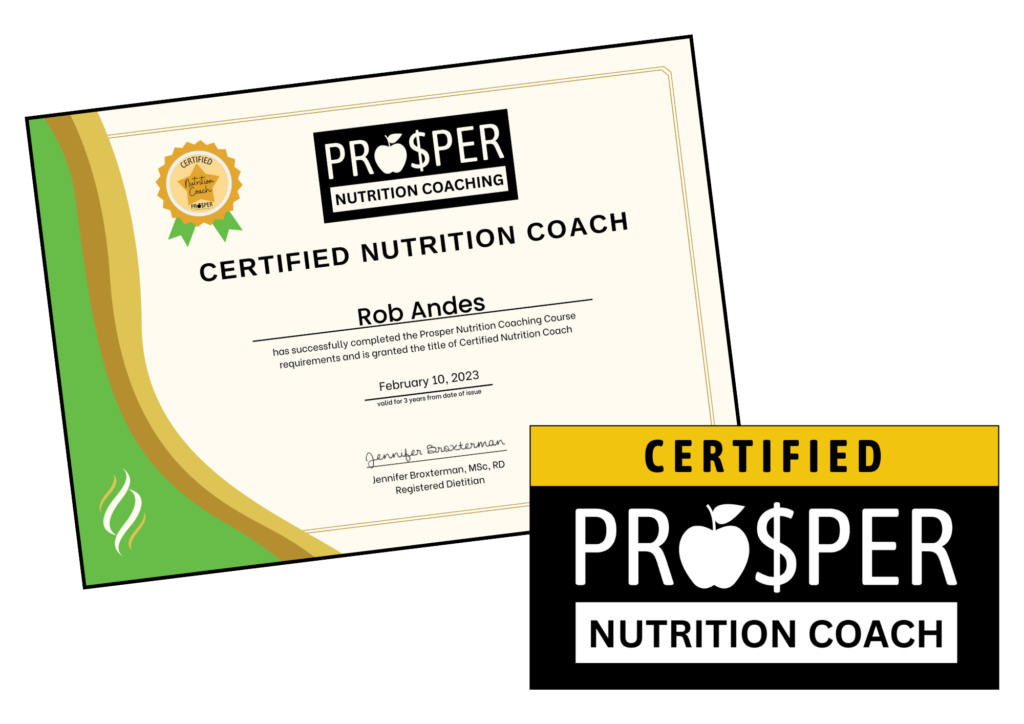

Why I dropped meal plans and macros for happy face nutrition coaching
Written by Jennifer Broxterman, MSc, RD
Registered Dietitian, Founder of NutritionRx

When I was a newer Registered Dietitian (RD), I thought my job was to write individualized meal plans and calculate macros for my nutrition clients, because:
a) I thought that’s what they wanted
b) I thought that’s what would help them succeed
c) everyone else was doing it, so I thought it’s what I was “supposed” to do as a nutrition coach
There is a trend in the fitness and nutrition industry to make things way more complicated than necessary.
But as I got more experienced, and as I continued my quest to read and learn as much as I could about habit formation and coaching behaviour change and what truly generated lasting results, two concepts kept smacking me in the fact until I was wise enough to start listening:
- keep it simple
- keep it client-centred
The most impactful, high-leverage behaviours that keep clients engaged and produce LASTING RESULTS, are almost always very simple. But don’t confuse simple with easy, they’re not the same thing. And don’t negate the power of simple actions, practiced daily, that compound over a lifetime.
When I decided to finally scrap meal plans, calorie counting, and macros in 99% of my nutrition clients (note: there’s always an exception to the rule where this can still be helpful to some people), I replaced it with a much simpler 7-Day Tracking Sheet. This exercise helps my clients perform a nutrition self-assessment, and builds their awareness around their eating habits in a powerful way.
I go into much more detail about how to teach and implement this tool in the Nutrition Coaching Course I created for health coaches, and this resource is included in the course material so you can download it to use with your own clients, but here’s a sample of what it looks like in action:
![]()
You’ll notice that we use a very simple 3 colour rating system to assess and bring awareness to the client’s food choices.
Instead of using a calorie or macro score, we start with something more immediately tangible to the client and make our assessment based on these 3 important factors:
• QUALITY:
Am I putting HIGH QUALITY food into my body?
• QUANTITY:
Am I putting the right QUANTITY of food into my body, based on my own personal needs?
• GOALS:
Did this choice move me in the direction of my goals?
Based on these 3 powerful questions, clients then self-assign one of the following faces to their choice.

• GREEN FACE = Amazing! Hell yeah!
• YELLOW FACE = Meh / so so. It was ok, not stellar, but not terrible.
• RED FACE = Joy/Off Track
I used to call this RED FACE a fail face, but I try not to label foods as being “good” or “bad” since eating food isn’t a moral act. It represents a food or beverage that brings us pleasure and enjoyment, but is less nutritious and therefore is something to only have occasionally instead of being an everyday choice that we make.
High School Grades Analogy
An analogy I find helpful is to think about getting good grades in high school, while also hopefully having a well-rounded life with sports, student council, music, drama, friends, jobs, volunteering, and other things to do outside of school work that match off with the person’s personal interests.
To achieve a high school average of 80%+, to help you succeed at this goal you would most likely need to develop a pattern of consistently good study habits, like:
- showing up to class on time, and skipping school infrequently
- staying off you phone so you can pay attention
- completing the homework assignments to help you learn and practice the material being taught
- turning in assignments on time
- putting in a reasonable good effort to study for upcoming tests
- trying your best
With mastery and practice of these good learning habits, hopefully your consistent effort will generate a lot of A’s (green faces), without you being a perfectionist wreck trying to get 100% all the time. You might have a B or C subject that needs some improvement (yellow face), and hopefully not too many bombed tests or assignments (red faces) where you’re failing out of school.
When we consider the context of achieving a “healthy balance”, going back to that grades example, as an employer, I would much rather hire someone who had an 86% average in high school, but they played sports, hung out with their friends, volunteered or worked at a part-time job, and went on dates and developed their relationship and interpersonal skills, then select the candidate who had a 99.9% average from high school, but failed to develop so many other areas of their life because studying and getting good grades was the be-all-end-all in their world.
Simplicity = Sustainability
Can you see the parallels to an unhealthy obsession with “perfect” or “clean eating”, and why good enough, really can be good enough?
Sometimes keeping it simple, in fact, radically simple, is best.
Simplicity = sustainability. The harder the program, the harder it is to stick to long-term.
You’ll also find that your clients’ initial motivation and engagement will eventually burn out if you make it all about logging their numbers and tracking macros online. Trust me, I’ve been there, and have made that mistake in the past, before I evolved and upgraded my nutrition coaching skills.
Learning about motivational interviewing and implementing that into my counselling sessions was one BIG thing that not only transformed the results my clients were getting, but also their enjoyment (and MY enjoyment) of working together long-term. Which is why it’s so important to keep nutrition and behaviour change simple, as well as client-centred, just like we cover in the Nutrition Coaching Course created for health coaches.
Because here’s another secret about great coaching: Beginners complicate. Experts simplify.
The 3 Faces / 3 Questions
Those 3 faces, those 3 colours, and those 3 questions are powerful, and are worth repeating again.
• QUALITY:
Am I putting HIGH QUALITY food into my body?
• QUANTITY:
Am I putting the right QUANTITY of food into my body, based on my own personal needs?
• GOALS:
Did this choice move me in the direction of my goals?
My job as a nutrition coach and Registered Dietitian (just like a tutor in school) is to meet my nutrition clients wherever they are at and to help walk them along the continuum of improvement, to help them achieve their health goals.

Maybe they’re starting at a 42% and just want to get to “good enough” at 70%, or maybe they’re starting at a 75% and want to get to 90% amazing based on their goals and what’s going on in life.
Either way, my job is not to judge or to put everyone on the same plan. My job is to HELP FIRST and to facilitate results for my nutrition clients by taking an individualized approach for each person to help them reach their own personal goals!
Wishing you health & happiness,
♡ Jen
Jennifer Broxterman, MSc, RD
Registered Dietitian
NutritionRx: happy, healthy living with our team of Registered Dietitians
Prosper Nutrition Coaching: a world-class nutrition coaching certification
+
+
+
Want to work with a NutritionRx Registered Dietitian?
Learn more here: Nutrition Packages & Rates
+
+
+
Want to become a Certified Nutrition Coach?
Learn more about our habits-based Prosper Nutrition Certification



